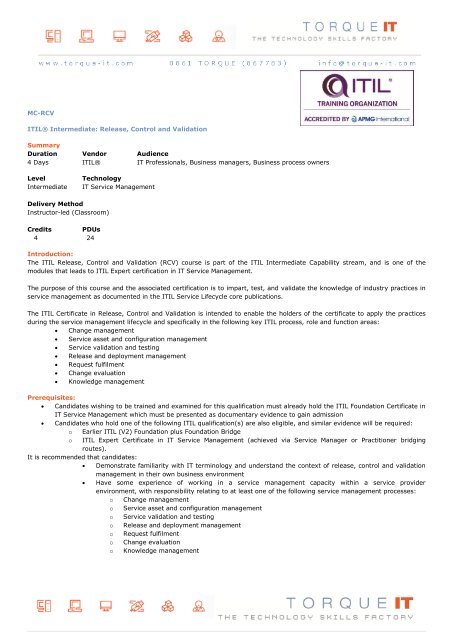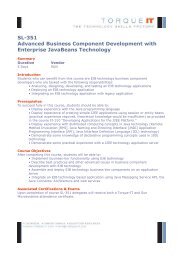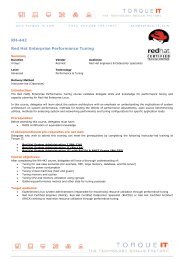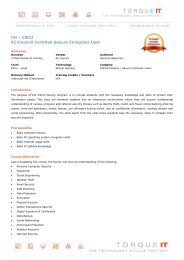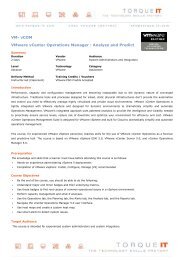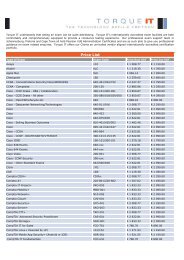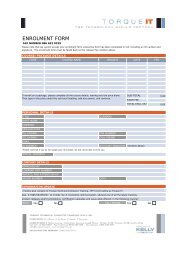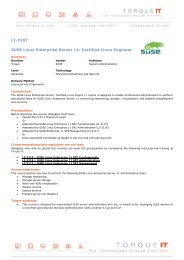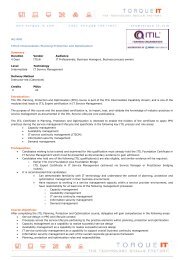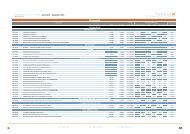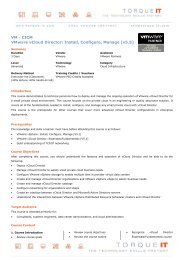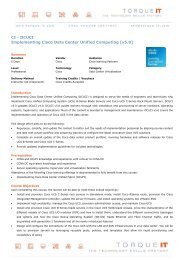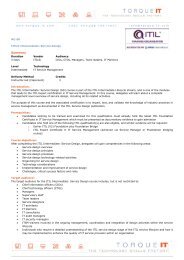MC-RCV ITIL Intermediate: Release, Control and ... - Torque IT
MC-RCV ITIL Intermediate: Release, Control and ... - Torque IT
MC-RCV ITIL Intermediate: Release, Control and ... - Torque IT
- No tags were found...
Create successful ePaper yourself
Turn your PDF publications into a flip-book with our unique Google optimized e-Paper software.
<strong>MC</strong>-<strong>RCV</strong><strong><strong>IT</strong>IL</strong>® <strong>Intermediate</strong>: <strong>Release</strong>, <strong>Control</strong> <strong>and</strong> ValidationSummaryDuration Vendor Audience4 Days <strong><strong>IT</strong>IL</strong>® <strong>IT</strong> Professionals, Business managers, Business process ownersLevel<strong>Intermediate</strong>Technology<strong>IT</strong> Service ManagementDelivery MethodInstructor-led (Classroom)Credits PDUs4 24Introduction:The <strong><strong>IT</strong>IL</strong> <strong>Release</strong>, <strong>Control</strong> <strong>and</strong> Validation (<strong>RCV</strong>) course is part of the <strong><strong>IT</strong>IL</strong> <strong>Intermediate</strong> Capability stream, <strong>and</strong> is one of themodules that leads to <strong><strong>IT</strong>IL</strong> Expert certification in <strong>IT</strong> Service Management.The purpose of this course <strong>and</strong> the associated certification is to impart, test, <strong>and</strong> validate the knowledge of industry practices inservice management as documented in the <strong><strong>IT</strong>IL</strong> Service Lifecycle core publications.The <strong><strong>IT</strong>IL</strong> Certificate in <strong>Release</strong>, <strong>Control</strong> <strong>and</strong> Validation is intended to enable the holders of the certificate to apply the practicesduring the service management lifecycle <strong>and</strong> specifically in the following key <strong><strong>IT</strong>IL</strong> process, role <strong>and</strong> function areas: Change management Service asset <strong>and</strong> configuration management Service validation <strong>and</strong> testing <strong>Release</strong> <strong>and</strong> deployment management Request fulfilment Change evaluation Knowledge managementPrerequisites: C<strong>and</strong>idates wishing to be trained <strong>and</strong> examined for this qualification must already hold the <strong><strong>IT</strong>IL</strong> Foundation Certificate in<strong>IT</strong> Service Management which must be presented as documentary evidence to gain admission C<strong>and</strong>idates who hold one of the following <strong><strong>IT</strong>IL</strong> qualification(s) are also eligible, <strong>and</strong> similar evidence will be required:o Earlier <strong><strong>IT</strong>IL</strong> (V2) Foundation plus Foundation Bridgeo <strong><strong>IT</strong>IL</strong> Expert Certificate in <strong>IT</strong> Service Management (achieved via Service Manager or Practitioner bridgingroutes).It is recommended that c<strong>and</strong>idates: Demonstrate familiarity with <strong>IT</strong> terminology <strong>and</strong> underst<strong>and</strong> the context of release, control <strong>and</strong> validationmanagement in their own business environment Have some experience of working in a service management capacity within a service providerenvironment, with responsibility relating to at least one of the following service management processes:o Change managemento Service asset <strong>and</strong> configuration managemento Service validation <strong>and</strong> testingo <strong>Release</strong> <strong>and</strong> deployment managemento Request fulfilmento Change evaluationo Knowledge management
Course objectives:After completing the <strong><strong>IT</strong>IL</strong> <strong>Release</strong>, <strong>Control</strong> <strong>and</strong> Validation course, delegates will gain competencies in the following areas: The importance of service management as a practice concept <strong>and</strong> service transition principles, purpose <strong>and</strong> objective The importance of <strong><strong>IT</strong>IL</strong> release, control <strong>and</strong> validation while providing service How all processes in <strong><strong>IT</strong>IL</strong> release, control <strong>and</strong> validation interact with other service lifecycle processes What are the processes, activities, methods <strong>and</strong> functions used in each of the <strong><strong>IT</strong>IL</strong> release, control <strong>and</strong> validationprocesses How to use the <strong><strong>IT</strong>IL</strong> release, control <strong>and</strong> validation processes, activities <strong>and</strong> functions to achieve operational excellence How to measure <strong><strong>IT</strong>IL</strong> release, control <strong>and</strong> validation The importance of <strong>IT</strong> security <strong>and</strong> its contributions to <strong><strong>IT</strong>IL</strong> release, control <strong>and</strong> validation The technology <strong>and</strong> implementation considerations surrounding <strong><strong>IT</strong>IL</strong> release, control <strong>and</strong> validation Change management as a capability to realize successful service transition Service validation <strong>and</strong> testing as a capability to ensure the integrity <strong>and</strong> the quality of service transition Service asset <strong>and</strong> configuration management as a capability to monitor the state of service transition Knowledge management as part of enhancing the on-going management decision support <strong>and</strong> service deliverycapability Request fulfilment <strong>and</strong> change evaluation to ensure meeting committed service level performance <strong>Release</strong>, control <strong>and</strong> validation process roles <strong>and</strong> responsibilities Technology <strong>and</strong> implementation considerations Challenges, critical success factors <strong>and</strong> risks associated with <strong><strong>IT</strong>IL</strong> release, control <strong>and</strong> validationTarget audience:The target audience for the <strong><strong>IT</strong>IL</strong> <strong>Release</strong>, <strong>Control</strong> <strong>and</strong> Validation course includes, but is not restricted to: <strong>IT</strong> Professionals Business managers Business process owners Individuals who require a deep underst<strong>and</strong>ing of the <strong><strong>IT</strong>IL</strong> Certificate in the <strong>Release</strong>, <strong>Control</strong> <strong>and</strong> Validation processes<strong>and</strong> of how it may be used to enhance the quality of <strong>IT</strong> service support within an organization. <strong>IT</strong> professionals who are working within an organization which has adopted <strong>and</strong> adapted <strong><strong>IT</strong>IL</strong> <strong>and</strong> who need to beinformed about, <strong>and</strong> thereafter contribute to an on-going service improvement programme Operational staff involved in change management, release <strong>and</strong> deployment management, service validation <strong>and</strong> testing,service asset <strong>and</strong> configuration management, request fulfilment, change evaluation <strong>and</strong> knowledge management, <strong>and</strong>who wish to enhance their role-based capabilities Individuals who have attained the <strong><strong>IT</strong>IL</strong> Foundation Certificate in <strong>IT</strong> Service Management <strong>and</strong> who wish to advance tohigher level <strong><strong>IT</strong>IL</strong> certifications Individuals seeking the <strong><strong>IT</strong>IL</strong> Expert Certificate in <strong>IT</strong> Service Management for which this qualification can be one of theprerequisite modules Individuals seeking progress toward the <strong><strong>IT</strong>IL</strong> Master Certificate in <strong>IT</strong> Service Management for which the <strong><strong>IT</strong>IL</strong> Expert is aprerequisite.
Course Content:Learning Unit <strong>RCV</strong>01:Introduction to release, control<strong>and</strong> validation The purpose, objectives <strong>and</strong>scope of service transitionlifecycle phase The <strong>RCV</strong> processes inrelation to service transition Activities related to overalltransition planning <strong>and</strong>ongoing supportLearning Unit <strong>RCV</strong>02: Changemanagement The end-to-end processflow for changemanagement, including itspolicies, design strategy,concepts, activities, <strong>and</strong>interfaces with otherprocesses A measurement model <strong>and</strong>the metrics that would beused to support changemanagement within <strong>RCV</strong>practices The benefits <strong>and</strong> businessvalue that can be gainedfrom change management<strong>and</strong> the challenges <strong>and</strong> risksto be managedLearning Unit <strong>RCV</strong>03: Serviceasset <strong>and</strong> configurationmanagement (SACM) The end-to-end processflow for service asset <strong>and</strong>configuration management,including its policies, designstrategy,concepts,activities <strong>and</strong> interfaceswith other processes A measurement model <strong>and</strong>the metrics that would beused to support serviceasset <strong>and</strong> configurationmanagement within <strong>RCV</strong>practices The benefits <strong>and</strong> businessvalue that can be gainedfrom service asset <strong>and</strong>configuration management<strong>and</strong> the challenges <strong>and</strong> risksto be managedLearning Unit <strong>RCV</strong>04: Servicevalidation <strong>and</strong> testing (SVT) The end-to-end processflow for the SVT process,including its policies,concepts, activities <strong>and</strong>interfaces with otherprocesses Test modeling techniques<strong>and</strong> testing concepts (forexample, stakeholderrequirements,testconditions, environments,data) <strong>and</strong> how these testcomponents are used toensure service quality A measurement model <strong>and</strong>the metrics that would beused to support servicevalidation <strong>and</strong> testing within<strong>RCV</strong> practices The benefits <strong>and</strong> businessvalue that can be gainedfrom SVT <strong>and</strong> thechallenges <strong>and</strong> risks to bemanagedLearning Unit <strong>RCV</strong>05: <strong>Release</strong><strong>and</strong> deployment management(RDM) The end-to-end processflow for release <strong>and</strong>deployment management,including its policies,concepts, phases, activities<strong>and</strong> interfaces with otherprocesses <strong>Release</strong> <strong>and</strong> deploymentmodels <strong>and</strong> relatedactivities (for example,design, planning, build,pilots, test, transfer,deployment, retirement)<strong>and</strong> how these activitiesensure service quality A measurement model <strong>and</strong>the metrics that would beused to support release <strong>and</strong>deployment managementwithin <strong>RCV</strong> practices The benefits <strong>and</strong> businessvalue that can be gainedfrom release <strong>and</strong>deployment managementLearning Unit <strong>RCV</strong>06: Requestfulfilment The end-to-end processflow for request fulfilment,including its policies,concepts, activities, <strong>and</strong>interfaces with otherprocesses (for example,RDM, SACM <strong>and</strong> changemanagement) Request fulfilment models<strong>and</strong> related activities (forexample, effectiveness ofdesigns,changes,performance) <strong>and</strong> howthese activities help toensure quality servicewithin <strong>RCV</strong> A measurement model <strong>and</strong>the metrics that would beused to support requestfulfillment within <strong>RCV</strong>practices The benefits <strong>and</strong> businessvalue that can be gainedfrom request fulfillment <strong>and</strong>the challenges <strong>and</strong> risks tobe managedLearning Unit <strong>RCV</strong>07: Changeevaluation The end-to-end processflow for change evaluation,including its policies,concepts,activitiesinterfaces with otherprocesses Perspectives <strong>and</strong>considerationsforevaluating the effectivenessof a service change A measurement model <strong>and</strong>the metrics that would beused to support changeevaluation within <strong>RCV</strong>practices The benefits <strong>and</strong> businessvalue that can be gainedfrom change evaluation <strong>and</strong>the challenges <strong>and</strong> risks tobe managedLearning Unit SOA08: Businessrelationship management Business relationshipmanagement, including itsconcepts, activities, roles<strong>and</strong> operation as well as itsorganizational structure <strong>and</strong>any interfaces with otherprocesses Metrics <strong>and</strong> CSFs associatedwith business relationshipmanagement in support ofSOALearning Unit <strong>RCV</strong>09: <strong>Release</strong>,control <strong>and</strong> validation roles <strong>and</strong>responsibilities
Generic roles that supportservice transition <strong>and</strong> the<strong>RCV</strong> processes The roles <strong>and</strong>responsibilities related totransition planning <strong>and</strong>support,changemanagement, service asset<strong>and</strong>configurationmanagement, servicevalidation <strong>and</strong> testing,release <strong>and</strong> deploymentmanagement, requestfulfilment,changeevaluation, <strong>and</strong> knowledgemanagement. Where <strong>and</strong> how these areused, as well as how they fitwithin the context of servicetransitionLearning Unit <strong>RCV</strong>10: Technology<strong>and</strong>ImplementationConsiderations The technologyrequirements for servicemanagement tools, where<strong>and</strong> how these would beused within <strong>RCV</strong> (forexample, knowledgemanagement <strong>and</strong> serviceasset <strong>and</strong> configurationmanagement) The need <strong>and</strong> benefits oftools that support servicetransition as related to <strong>RCV</strong> Implementing <strong>RCV</strong>processes in the context ofplanning <strong>and</strong> managingchange, service operation,project management, riskmanagement, <strong>and</strong> staffconsiderations.Associated Certifications & Exam:This course will prepare delegates to write the <strong><strong>IT</strong>IL</strong> <strong>Intermediate</strong> <strong>RCV</strong> exam in <strong>IT</strong> Service Management.Successfully passing this exam will result in the attainment of the <strong><strong>IT</strong>IL</strong> <strong>Intermediate</strong> <strong>Release</strong>, <strong>Control</strong> <strong>and</strong> ValidationCertificate in <strong>IT</strong> Service Management.Exam Prerequisite:TypeCompletion of an Accredited course from an <strong><strong>IT</strong>IL</strong> Accredited Training ProviderEight (8) multiple choice, scenario-based, gradient scored questions.Each question will have 4 possible answer options, one of which is worth 5 marks, one which is worth 3 marks, onewhich is worth 1 mark, <strong>and</strong> one which is a distracter <strong>and</strong> achieves no marks.Duration Maximum 90 minutes for all c<strong>and</strong>idates in their respective language.Provisions for additional time relating to language C<strong>and</strong>idates completing an exam in a language that is not their mother tongue, <strong>and</strong> where the language of the exam isnot their primary business language, have a maximum of 120 minutes to complete the exam <strong>and</strong> are allowed the use ofa dictionaryPass score:28/40 or 70%Upon successful completion of this course, delegates will receive a <strong>Torque</strong> <strong>IT</strong> course attendance certificate.The Swirl logo is a trade mark of AXELOS Limited<strong><strong>IT</strong>IL</strong>® is a registered trade mark of AXELOS Limited


